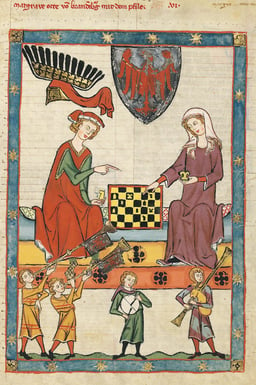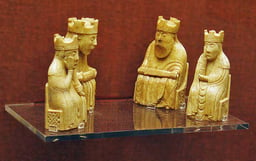Chess
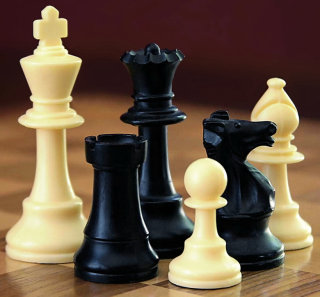
Chess

| Years active | c.6th-century to present |
|---|---|
| Genre(s) | Board game Abstract strategy game Mind sport |
| Players | 2 |
| Playing time | Casual games usually last 10 to 60 minutes; tournament games last anywhere from about ten minutes (fast chess) to six hours or more. |
| Random chance | None |
| Skill(s) required | Strategy, tactics |
Chess is a two-player strategy board game played on a checkered board with 64 squares arranged in an 8×8 grid.[11] The game is played by millions of people worldwide. Chess is believed to be derived from the Indian game chaturanga sometime before the 7th century. Chaturanga is also the likely ancestor of the Eastern strategy games xiangqi (Chinese chess), janggi (Korean chess), and shogi (Japanese chess). Chess reached Europe by the 9th century, due to the Umayyad conquest of Hispania. The pieces assumed their current powers in Spain in the late 15th century; the modern rules were standardized in the 19th century.
Play involves no hidden information. Each player begins with 16 pieces: one king, one queen, two rooks, two knights, two bishops, and eight pawns. Each piece type moves differently, with the most powerful being the queen and the least powerful the pawn. The objective is to checkmate[1] the opponent's king by placing it under an inescapable threat of capture. To this end, a player's pieces are used to attack and capture the opponent's pieces, while supporting each other. During the game, play typically involves exchanging pieces for the opponent's similar pieces, and finding and engineering opportunities to trade advantageously or to get a better position. In addition to checkmate, a player wins the game if the opponent resigns, or (in a timed game) runs out of time. There are also several ways that a game can end in a draw.
The first generally recognized World Chess Champion, Wilhelm Steinitz, claimed his title in 1886. Since 1948, the World Championship has been regulated by the Fédération Internationale des Échecs (FIDE), the game's international governing body. FIDE also awards life-time master titles to skilled players, the highest of which is Grandmaster (GM). Many national chess organizations have a title system of their own. FIDE also organizes the Women's World Championship, the World Junior Championship, the World Senior Championship, the Blitz and Rapid World Championships, and the Chess Olympiad, a popular competition among international teams. FIDE is a member of the International Olympic Committee, which can be considered recognition of chess as a sport.[13] Several national sporting bodies (e.g. the Spanish Consejo Superior de Deportes[14]) also recognize chess as a sport. Chess was included in the 2006 and 2010 Asian Games. There is also a Correspondence Chess World Championship and a World Computer Chess Championship. Online chess has opened amateur and professional competition to a wide and varied group of players.
Since the second half of the 20th century, chess engines have been programmed to play with increasing success, to the point where the strongest programs play at a higher level than the best human players. Since the 1990s, computer analysis has contributed significantly to chess theory, particularly in the endgame. The IBM computer Deep Blue was the first machine to overcome a reigning World Chess Champion in a match when it defeated Garry Kasparov in 1997. The rise of strong chess engines runnable on hand-held devices has led to increasing concern about cheating during tournaments.
There are many variants of chess that utilize different rules, pieces, or boards. One of these, Chess960, has gained widespread popularity as well as some FIDE recognition.
| Years active | c.6th-century to present |
|---|---|
| Genre(s) | Board game Abstract strategy game Mind sport |
| Players | 2 |
| Playing time | Casual games usually last 10 to 60 minutes; tournament games last anywhere from about ten minutes (fast chess) to six hours or more. |
| Random chance | None |
| Skill(s) required | Strategy, tactics |
Rules
The rules of chess are published by FIDE (Fédération Internationale des Échecs), chess's international governing body, in its Handbook.[15] Rules published by national governing bodies, or by unaffiliated chess organizations, commercial publishers, etc., may differ. FIDE's rules were most recently revised in 2017.
Setup

Initial position, first (bottom) row: rook, knight, bishop, queen, king, bishop, knight, and rook; second row: pawns
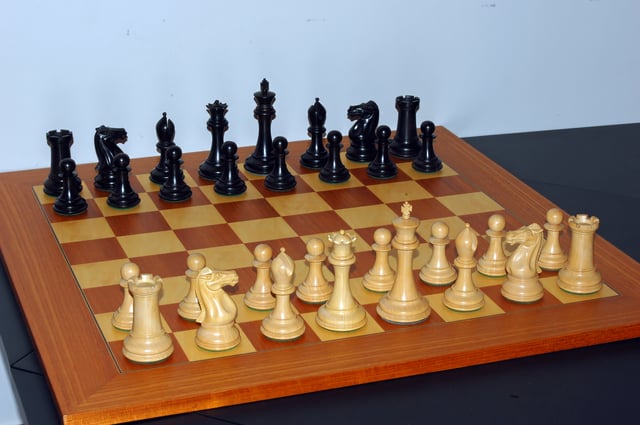
Setup at the start of a game
By convention, chess game pieces are divided into white and black sets. Each set consists of 16 pieces: one king, one queen, two rooks, two bishops, two knights, and eight pawns. The pieces are set out as shown in the diagram and photo. The players of the sets are referred to as White and Black, respectively.
The game is played on a square board of eight rows (called ranks, denoted 1 to 8 from bottom to top according to White's perspective) and eight columns (called files, denoted a to h from left to right according to White's perspective). The 64 squares alternate in color and are referred to as light and dark squares. The chessboard is placed with a light square at the right-hand corner nearest to each player. Thus, each queen starts on a square of its own color (the white queen on a light square; the black queen on a dark square).
Movement
In competitive games, the colors are allocated by the organizers; in informal games, the colors are usually decided randomly, for example by coin toss, or by one player's concealing a white and black pawn in either hand and having the opponent choose. White moves first, after which players alternate turns, moving one piece per turn (except for castling, when two pieces are moved). A piece is moved to either an unoccupied square or one occupied by an opponent's piece, which is captured and removed from play. With the sole exception of en passant, all pieces capture by moving to the square that the opponent's piece occupies.
Moving is compulsory; it is illegal to skip a turn, even when having to move is detrimental. A player may not make any move that would put or leave the player's own king in check. If the player to move has no legal move, the game is over; the result is either checkmate (a loss for the player with no legal move) if the king is in check, or stalemate (a draw) if the king is not.
Each piece has its own way of moving. In the diagrams, the dots mark the squares to which the piece can move if there are no intervening piece(s) of either color (except the knight, which leaps over any intervening pieces).
The king moves one square in any direction. The king also has a special move called castling that involves also moving a rook.
A rook can move any number of squares along a rank or file, but cannot leap over other pieces. Along with the king, a rook is involved during the king's castling move.
A bishop can move any number of squares diagonally, but cannot leap over other pieces.
The queen combines the power of a rook and bishop and can move any number of squares along a rank, file, or diagonal, but cannot leap over other pieces.
A knight moves to any of the closest squares that are not on the same rank, file, or diagonal. (Thus the move forms an "L"-shape: two squares vertically and one square horizontally, or two squares horizontally and one square vertically.) The knight is the only piece that can leap over other pieces.
A pawn can move forward to the unoccupied square immediately in front of it on the same file, or on its first move it can advance two squares along the same file, provided both squares are unoccupied (black dots in the diagram); or the pawn can capture an opponent's piece on a square diagonally in front of it on an adjacent file, by moving to that square (black "x"s). A pawn has two special moves: the en passant capture and promotion.
Castling

Examples of castling (view animation [209] )
Once in every game, each king can make a special move, known as castling. Castling consists of moving the king two squares along the first rank toward a rook (that is on the player's first rank and then placing the rook on the last square that the king just crossed. Castling is permissible if the following conditions are met:[16]
Neither the king nor the rook has previously moved during the game.
There are no pieces between the king and the rook.
The king cannot be in check, nor can the king pass through any square that is under attack by an enemy piece, or move to a square that would result in check. (Note that castling is permitted if the rook is under attack, or if the rook crosses an attacked square.)
En passant
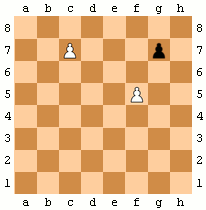
Examples of pawn moves: (left) promotion; (right) en passant
When a pawn makes a two-step advance from its starting position and there is an opponent's pawn on a square next to the destination square on an adjacent file, then the opponent's pawn can capture it en passant ("in passing"), moving to the square the pawn passed over. This can be done only on the very next turn; otherwise the right to do so is forfeited. For example, in the animated diagram, the black pawn advances two steps from g7 to g5, and the white pawn on f5 can take it en passant on g6 (but only on White's next move).
Promotion
When a pawn advances to the eighth rank, as a part of the move it is promoted and must be exchanged for the player's choice of queen, rook, bishop, or knight of the same color. Usually, the pawn is chosen to be promoted to a queen, but in some cases another piece is chosen; this is called underpromotion. In the animated diagram, the pawn on c7 can be advanced to the eighth rank and be promoted. There is no restriction on the piece promoted to, so it is possible to have more pieces of the same type than at the start of the game (e.g., two or more queens).
Check

The black king is in check by the rook.
When a king is under immediate attack by one or two of the opponent's pieces, it is said to be in check. A move in response to a check is legal only if it results in a position where the king is no longer in check. This can involve capturing the checking piece; interposing a piece between the checking piece and the king (which is possible only if the attacking piece is a queen, rook, or bishop and there is a square between it and the king); or moving the king to a square where it is not under attack. Castling is not a permissible response to a check.
The object of the game is to checkmate the opponent; this occurs when the opponent's king is in check, and there is no legal way to remove it from attack. It is never legal for a player to make a move that puts or leaves the player's own king in check. In casual games it is common to announce "check" when putting the opponent's king in check, but this is not required by the rules of chess, and is not usually done in tournaments.
End of the game
Win

White is in checkmate, being unable to escape attack by the black bishops.
Games can be won in the following ways:
Checkmate: The player whose turn it is to move is in check and has no legal move to escape check.
Resignation: Either player may resign, conceding the game to the opponent.[17] It is usually considered poor etiquette to play on in a hopeless position, and for this reason high-level games rarely end in checkmate.
Win on time: In games with a time control, a player wins if the opponent runs out of time, even if the opponent has a superior position, as long as the player has a theoretical possibility to checkmate the opponent.
Forfeit: A player who cheats, violates the rules, or violates the rules specified for the particular tournament, can be forfeited. In high-level tournaments, players have been forfeited for such things as: arriving late for the game (even by a matter of seconds); receiving a call or text on a cell phone; refusing to undergo a drug test; refusing to undergo a body search for electronic devices; unsporting behavior (e.g. refusing to shake hands with the opponent).
Draw

Black is not in check and has no legal move. The result is stalemate.
There are several ways games can end in a draw:
Draw by agreement: Draws are most commonly reached by mutual agreement between the players. The correct procedure is to verbally offer the draw, make a move, then start the opponent's clock. Traditionally, players have been allowed to agree to a draw at any point in the game, occasionally even without playing a move; in recent years efforts have been made to discourage short draws, for example by forbidding draw offers before move thirty.
Stalemate: The player whose turn it is to move has no legal move and is not in check.
Threefold repetition of position: This most commonly occurs when neither side is able to avoid repeating moves without incurring a disadvantage. In this situation, either player can claim a draw; this requires the players to keep a valid written record of the game so that the claim can be verified by the arbiter if challenged. The three occurrences of the position need not occur on consecutive moves for a claim to be valid. FIDE rules make no mention of perpetual check; this is merely a specific type of draw by threefold repetition.
Fifty-move rule: If during the previous 50 moves no pawn has been moved and no capture has been made, either player can claim a draw. There are several known endgames where it is possible to force a mate but it requires more than 50 moves before a pawn move or capture is made; examples include some endgames with two knights against a pawn and some pawnless endgames such as queen against two bishops. Historically, FIDE has sometimes revised the fifty-move rule to make exceptions for these endgames, but these have since been repealed. Some correspondence chess organizations do not enforce the fifty-move rule.[2]
Fivefold repetition of position: Similar to the threefold-repetition rule, but in this case neither player needs to claim the draw; thus a tournament director can intervene and declare the game to be drawn. This is a relatively recent (2014) addition to the FIDE rules.
Seventy-five-move rule: Similar to the fifty-move rule, but as with the fivefold repetition rule, this applies independently of claims by the players, and allows a tournament director to intervene. This rule likewise is a recent addition to the FIDE rules.
Insufficient material: If neither player has a theoretical possibility to checkmate the opponent; for example, if a player has only the king and a knight, and the opponent has only the king, checkmate is impossible and the game is drawn by this rule. On the other hand, if both players still have a knight there is a highly unlikely yet theoretical possibility of checkmate, so this rule does not apply.
Draw on time: In games with a time control, the game is drawn if a player is out of time and the opponent has no theoretical possibility to checkmate the player.
Time control

A digital chess clock
In competition, chess games are played with a time control. If a player's time runs out before the game is completed, the game is automatically lost (provided the opponent has enough pieces left to deliver checkmate). The duration of a game ranges from long (or "classical") games which can take up to seven hours (even longer if adjournments are permitted) to bullet chess (under 3 minutes per player for the entire game). Intermediate between these are rapid chess games, lasting between 20 minutes and two hours per game, a popular time control in amateur weekend tournaments.
Time is controlled using a chess clock that has two displays, one for each player's remaining time. Analog chess clocks have been largely replaced by digital clocks, which allow for time controls with increments.
Time controls are also enforced in correspondence chess competition. A typical time control is 50 days for every 10 moves.
History
Predecessors
Chess is believed to have originated in Eastern India, c. 280–550,[19] in the Gupta Empire,[20][21][22][23] where its early form in the 6th century was known as chaturaṅga (Sanskrit: चतुरङ्ग), literally four divisions [of the military] – infantry, cavalry, elephants, and chariotry, represented by the pieces that would evolve into the modern pawn, knight, bishop, and rook, respectively. Thence it spread eastward and westward along the Silk Road. The earliest evidence of chess is found in the nearby Sassanid Persia around 600, where the game came to be known by the name chatrang. Chatrang was taken up by the Muslim world after the Islamic conquest of Persia (633–44), where it was then named shatranj, with the pieces largely retaining their Persian names. In Spanish "shatranj" was rendered as ajedrez ("al-shatranj"), in Portuguese as xadrez, and in Greek as ζατρίκιον (zatrikion, which comes directly from the Persian chatrang),[24] but in the rest of Europe it was replaced by versions of the Persian shāh ("king"), which was familiar as an exclamation and became the English words "check" and "chess".[3]
The oldest archaeological chess artifacts, ivory pieces, were excavated in ancient Afrasiab, today's Samarkand, in Uzbekistan, central Asia, and date to about 760, with some of them possibly older. The oldest known chess manual was in Arabic and dates to 840–850, written by al-Adli ar-Rumi (800–870), a renowned Arab chess player, titled Kitab ash-shatranj (Book of the chess). This is a lost manuscript, but referenced in later works. The eastern migration of chess, into China and Southeast Asia, has even less documentation than its migration west. The first reference to Chinese chess, called xiàngqí 象棋, appears in a book entitled Xuán guaì lù 玄怪錄 ("Record of the Mysterious and Strange"), dating to about 800. Alternatively, some contend that chess arose from Chinese chess or one of its predecessors,[25] although this has been contested.[26]
The game reached Western Europe and Russia by at least three routes, the earliest being in the 9th century. By the year 1000, it had spread throughout both Muslim Iberia and Latin Europe.[27] A Latin poem de scachis dated to the late 10th century has been preserved in Einsiedeln Abbey. A famous 13th-century manuscript covering shatranj, backgammon, and dice is known as the Libro de los juegos.
1200–1700: Origins of the modern game
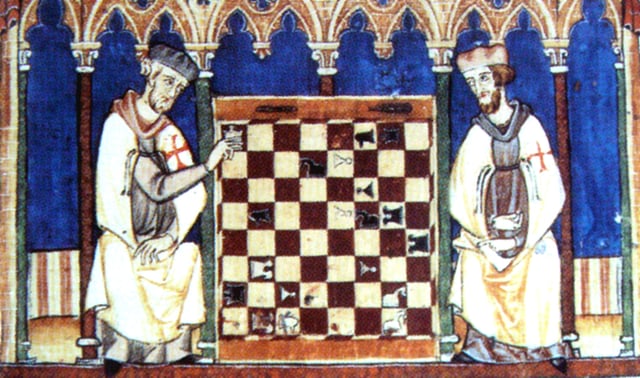
Knights Templar playing chess, Libro de los juegos, 1283
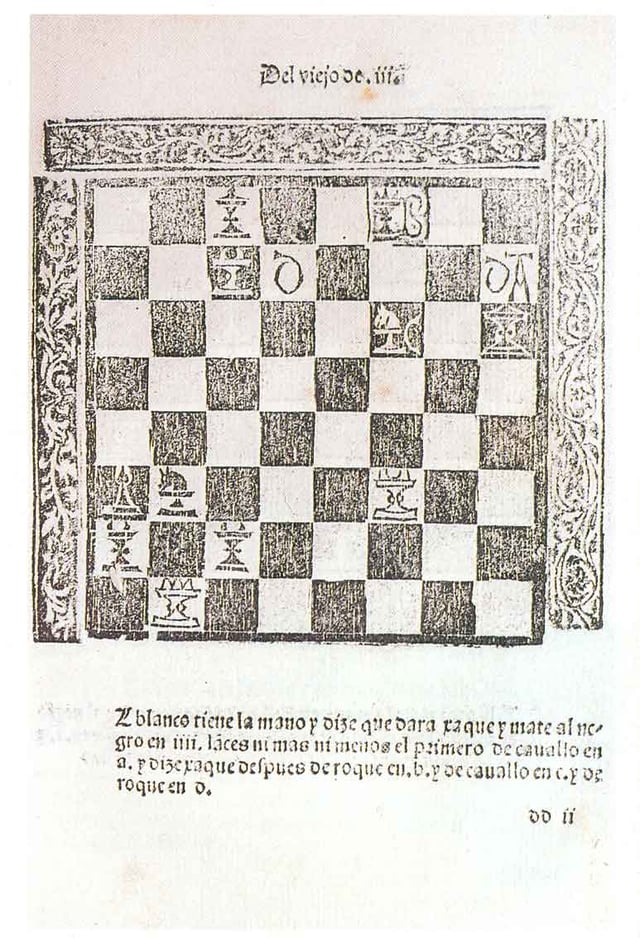
A tactical puzzle from Lucena's 1497 book
Around 1200, the rules of shatranj started to be modified in southern Europe, and around 1475, several major changes made the game essentially as it is known today.[27] These modern rules for the basic moves had been adopted in Italy and Spain.[28][29] Pawns gained the option of advancing two squares on their first move, while bishops and queens acquired their modern abilities. The queen replaced the earlier vizier chess piece towards the end of the 10th century and by the 15th century had become the most powerful piece;[30] consequently modern chess was referred to as "Queen's Chess" or "Mad Queen Chess".[31] Castling, derived from the "kings leap" usually in combination with a pawn or rook move to bring the king to safety, was introduced. These new rules quickly spread throughout western Europe.
Writings about the theory of how to play chess began to appear in the 15th century. The Repetición de Amores y Arte de Ajedrez (Repetition of Love and the Art of Playing Chess) by Spanish churchman Luis Ramirez de Lucena was published in Salamanca in 1497.[29] Lucena and later masters like Portuguese Pedro Damiano, Italians Giovanni Leonardo Di Bona, Giulio Cesare Polerio and Gioachino Greco, and Spanish bishop Ruy López de Segura developed elements of openings and started to analyze simple endgames.
1700–1873: The Romantic Era in chess
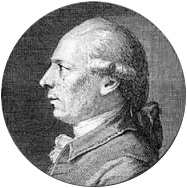
François-André Danican Philidor, 18th-century French chess master

The "Immortal Game", Anderssen vs. Kieseritzky, 1851
In the 18th century, the center of European chess life moved from the Southern European countries to France. The two most important French masters were François-André Danican Philidor, a musician by profession, who discovered the importance of pawns for chess strategy, and later Louis-Charles Mahé de La Bourdonnais, who won a famous series of matches with the Irish master Alexander McDonnell in 1834.[32] Centers of chess activity in this period were coffee houses in major European cities like Café de la Régence in Paris and Simpson's Divan in London.[33][34]
The rules concerning stalemate were finalized in the early 19th century. Also in the 19th century, the convention that White moves first was established (formerly either White or Black could move first). Finally the rules around castling were standardized – variations in the castling rules had persisted in Italy until the late 19th century. The resulting standard game is sometimes referred to as Western chess[35] or international chess,[36] particularly in Asia where other games of the chess family such as xiangqi are prevalent. Since the 19th century, the only rule changes have been technical in nature, for example establishing the correct procedure for claiming a draw by repetition.
As the 19th century progressed, chess organization developed quickly. Many chess clubs, chess books, and chess journals appeared. There were correspondence matches between cities; for example, the London Chess Club played against the Edinburgh Chess Club in 1824.[37] Chess problems became a regular part of 19th-century newspapers; Bernhard Horwitz, Josef Kling, and Samuel Loyd composed some of the most influential problems. In 1843, von der Lasa published his and Bilguer's Handbuch des Schachspiels (Handbook of Chess), the first comprehensive manual of chess theory.
The first modern chess tournament was organized by Howard Staunton, a leading English chess player, and was held in London in 1851. It was won by the German Adolf Anderssen, who was hailed as the leading chess master. His brilliant, energetic attacking style was typical for the time.[40][41] Sparkling games like Anderssen's Immortal Game and Evergreen Game or Morphy's "Opera Game" were regarded as the highest possible summit of the chess art.[42]
The romantic era was characterized by opening gambits (sacrificing pawns or even pieces), daring attacks, and brazen sacrifices. Many elaborate and beautiful but unsound move sequences called "combinations" were played by the masters of the time. The game was played more for art than theory. A profound belief that chess merit resided in the players' genius rather than inherent in the position on the board pervaded chess practice.
Deeper insight into the nature of chess came with the American Paul Morphy, an extraordinary chess prodigy. Morphy won against all important competitors (except Staunton, who refused to play), including Anderssen, during his short chess career between 1857 and 1863. Morphy's success stemmed from a combination of brilliant attacks and sound strategy; he intuitively knew how to prepare attacks.[43]
1873–1945: Birth of a sport
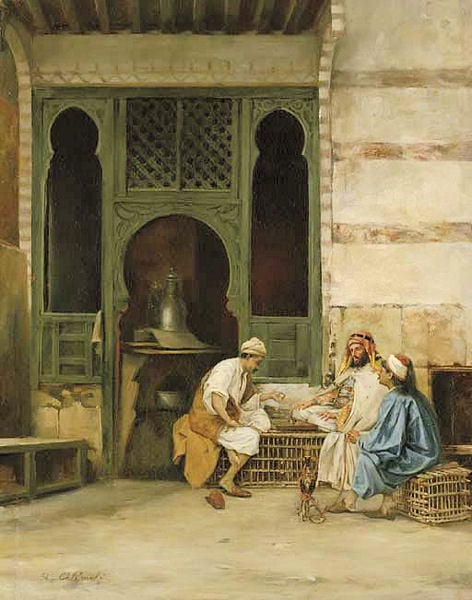
Chess Players, Cairo by Stanisław Chlebowski (1835–1884)
Prague-born Wilhelm Steinitz beginning in 1873 described how to avoid weaknesses in one's own position and how to create and exploit such weaknesses in the opponent's position.[44] The scientific approach and positional understanding of Steinitz revolutionized the game. Steinitz was the first to break a position down into its components.[45] Before Steinitz, players brought their queen out early, did not completely develop their other pieces, and mounted a quick attack on the opposing king, which either succeeded or failed. The level of defense was poor and players did not form any deep plan.[46] In addition to his theoretical achievements, Steinitz founded an important tradition: his triumph over the leading German master Johannes Zukertort in 1886 is regarded as the first official World Chess Championship. Steinitz lost his crown in 1894 to a much younger player, the German mathematician Emanuel Lasker, who maintained this title for 27 years, the longest tenure of any world champion.[47]
After the end of the 19th century, the number of master tournaments and matches held annually quickly grew. Some sources state that in 1914 the title of chess Grandmaster was first formally conferred by Tsar Nicholas II of Russia to Lasker, Capablanca, Alekhine, Tarrasch, and Marshall, but this is a disputed claim.[4] The tradition of awarding such titles was continued by the World Chess Federation (FIDE), founded in 1924 in Paris. In 1927, the Women's World Chess Championship was established; the first to hold the title was Czech-English master Vera Menchik.[48]
It took a prodigy from Cuba, José Raúl Capablanca (World Champion 1921–1927), who loved simple positions and endgames, to end the German-speaking dominance in chess; he was undefeated in tournament play for eight years, until 1924. His successor was Russian-French Alexander Alekhine, a strong attacking player who died as the world champion in 1946. He briefly lost the title to Dutch player Max Euwe in 1935 and regained it two years later.[49]
Between the world wars, chess was revolutionized by the new theoretical school of so-called hypermodernists like Aron Nimzowitsch and Richard Réti. They advocated controlling the center of the board with distant pieces rather than with pawns, thus inviting opponents to occupy the center with pawns, which become objects of attack.[50]
1945–present: Post-World War II era
After the death of Alekhine, a new World Champion was sought. FIDE, which has controlled the title since then (except for one interruption), ran a tournament of elite players. The winner of the 1948 tournament, Russian Mikhail Botvinnik, started an era of Soviet dominance in the chess world. Until the end of the Soviet Union, there was only one non-Soviet champion, American Bobby Fischer (champion 1972–1975).[51] Botvinnik revolutionized opening theory. Previously Black strove for equality, to neutralize White's first-move advantage. As Black, Botvinnik strove for the initiative from the beginning.[52] In the previous informal system of World Championships, the current champion decided which challenger he would play for the title and the challenger was forced to seek sponsors for the match. FIDE set up a new system of qualifying tournaments and matches. The world's strongest players were seeded into Interzonal tournaments, where they were joined by players who had qualified from Zonal tournaments. The leading finishers in these Interzonals would go on the "Candidates" stage, which was initially a tournament, and later a series of knockout matches. The winner of the Candidates would then play the reigning champion for the title. A champion defeated in a match had a right to play a rematch a year later. This system operated on a three-year cycle. Botvinnik participated in championship matches over a period of fifteen years. He won the world championship tournament in 1948 and retained the title in tied matches in 1951 and 1954. In 1957, he lost to Vasily Smyslov, but regained the title in a rematch in 1958. In 1960, he lost the title to the 23-year-old Latvian prodigy Mikhail Tal, an accomplished tactician and attacking player. Botvinnik again regained the title in a rematch in 1961.
Following the 1961 event, FIDE abolished the automatic right of a deposed champion to a rematch, and the next champion, Armenian Tigran Petrosian, a player renowned for his defensive and positional skills, held the title for two cycles, 1963–1969. His successor, Boris Spassky from Russia (champion 1969–1972), won games in both positional and sharp tactical style.[53] The next championship, the so-called Match of the Century, saw the first non-Soviet challenger since World War II, American Bobby Fischer, who defeated his Candidates opponents by unheard-of margins and clearly won the world championship match. In 1975, however, Fischer refused to defend his title against Soviet Anatoly Karpov when FIDE did not meet his demands, and Karpov obtained the title by default.[54] Fischer modernized many aspects of chess, especially by extensively preparing openings.[55]
Karpov defended his title twice against Viktor Korchnoi and dominated the 1970s and early 1980s with a string of tournament successes.[56] Karpov's reign finally ended in 1985 at the hands of Garry Kasparov, another Soviet player from Baku, Azerbaijan. Kasparov and Karpov contested five world title matches between 1984 and 1990; Karpov never won his title back.[57] In 1993, Garry Kasparov and Nigel Short broke with FIDE to organize their own match for the title and formed a competing Professional Chess Association (PCA). From then until 2006, there were two simultaneous World Champions and World Championships: the PCA or Classical champion extending the Steinitzian tradition in which the current champion plays a challenger in a series of many games, and the other following FIDE's new format of many players competing in a tournament to determine the champion. Kasparov lost his Classical title in 2000 to Vladimir Kramnik of Russia.[58] The World Chess Championship 2006, in which Kramnik beat the FIDE World Champion Veselin Topalov, reunified the titles and made Kramnik the undisputed World Chess Champion.[59] In September 2007, he lost the title to Viswanathan Anand of India, who won the championship tournament in Mexico City. Anand defended his title in the revenge match of 2008,[60] 2010 and 2012. In 2013, Magnus Carlsen beat Anand in the 2013 World Chess Championship.[61] He defended his title the following year, again against Anand. Carlsen confirmed his title in 2016 against the Russian Sergey Karjakin [62] and in 2018 against the American Fabiano Caruana,[63] in both occasions by a rapid tiebreaker match after equality in 12 games of classical time control, and is the reigning world champion.
Place in culture
Pre-modern
In the Middle Ages and during the Renaissance, chess was a part of noble culture; it was used to teach war strategy and was dubbed the "King's Game".[64] Gentlemen are "to be meanly seene in the play at Chestes", says the overview at the beginning of Baldassare Castiglione's The Book of the Courtier (1528, English 1561 by Sir Thomas Hoby), but chess should not be a gentleman's main passion. Castiglione explains it further:
And what say you to the game at chestes? It is truely an honest kynde of enterteynmente and wittie, quoth Syr Friderick. But me think it hath a fault, whiche is, that a man may be to couning at it, for who ever will be excellent in the playe of chestes, I beleave he must beestowe much tyme about it, and applie it with so much study, that a man may assoone learne some noble scyence, or compase any other matter of importaunce, and yet in the ende in beestowing all that laboure, he knoweth no more but a game. Therfore in this I beleave there happeneth a very rare thing, namely, that the meane is more commendable, then the excellency.[65]
Many of the elaborate chess sets used by the aristocracy have been lost, but others partially survive, such as the Lewis chessmen.
Chess was often used as a basis of sermons on morality. An example is Liber de moribus hominum et officiis nobilium sive super ludo scacchorum ('Book of the customs of men and the duties of nobles or the Book of Chess'), written by an Italian Dominican monk Jacobus de Cessolis c. 1300. This book was one of the most popular of the Middle Ages.[66] The work was translated into many other languages (the first printed edition was published at Utrecht in 1473) and was the basis for William Caxton's The Game and Playe of the Chesse (1474), one of the first books printed in English.[67] Different chess pieces were used as metaphors for different classes of people, and human duties were derived from the rules of the game or from visual properties of the chess pieces:[68]
The knyght ought to be made alle armed upon an hors in suche wyse that he haue an helme on his heed and a spere in his ryght hande/ and coueryd wyth his sheld/ a swerde and a mace on his lyft syde/ Cladd wyth an hawberk and plates to fore his breste/ legge harnoys on his legges/ Spores on his heelis on his handes his gauntelettes/ his hors well broken and taught and apte to bataylle and couerid with his armes/ whan the knyghtes ben maad they ben bayned or bathed/ that is the signe that they shold lede a newe lyf and newe maners/ also they wake alle the nyght in prayers and orysons vnto god that he wylle gyue hem grace that they may gete that thynge that they may not gete by nature/ The kynge or prynce gyrdeth a boute them a swerde in signe/ that they shold abyde and kepe hym of whom they take theyr dispenses and dignyte.[69]
Known in the circles of clerics, students, and merchants, chess entered into the popular culture of Middle Ages. An example is the 209th song of Carmina Burana from the 13th century, which starts with the names of chess pieces, Roch, pedites, regina...[70]
Modern

Through the Looking-Glass: the Red King is snoring. Illustration by Sir John Tenniel.
During the Age of Enlightenment, chess was viewed as a means of self-improvement. Benjamin Franklin, in his article "The Morals of Chess" (1750), wrote:
The Game of Chess is not merely an idle amusement; several very valuable qualities of the mind, useful in the course of human life, are to be acquired and strengthened by it, so as to become habits ready on all occasions; for life is a kind of Chess, in which we have often points to gain, and competitors or adversaries to contend with, and in which there is a vast variety of good and ill events, that are, in some degree, the effect of prudence, or the want of it. By playing at Chess then, we may learn: I. Foresight, which looks a little into futurity, and considers the consequences that may attend an action [...] II. Circumspection, which surveys the whole Chess-board, or scene of action: – the relation of the several Pieces, and their situations [...] III. Caution, not to make our moves too hastily [...][71]
With these or similar views, chess is taught to children in schools around the world today. Many schools host chess clubs, and there are many scholastic tournaments specifically for children. Tournaments are held regularly in many countries, hosted by organizations such as the United States Chess Federation and the National Scholastic Chess Foundation.[72]
Chess is often depicted in the arts; significant works where chess plays a key role range from Thomas Middleton's A Game at Chess to Through the Looking-Glass by Lewis Carroll, to Vladimir Nabokov's The Defense, to The Royal Game by Stefan Zweig. Chess is featured in films like Ingmar Bergman's The Seventh Seal and Satyajit Ray's The Chess Players.
Chess is also present in contemporary popular culture. For example, the characters in Star Trek play a futuristic version of the game called "Tri-Dimensional Chess". "Wizard's Chess" is featured in J.K. Rowling's Harry Potter plays. The hero of Searching for Bobby Fischer struggles against adopting the aggressive and misanthropic views of a world chess champion.[73] Chess is used as the core theme in the musical Chess by Tim Rice, Björn Ulvaeus, and Benny Andersson. The thriller film Knight Moves is about a chess grandmaster who is accused of being a serial killer. Pawn Sacrifice, starring Tobey Maguire as Bobby Fischer and Liev Schreiber as Boris Spassky, depicts the drama surrounding the 1972 World Chess Championship in Iceland during the Cold War.[74]
Prohibition in Islam
In 1979 in Islamic Republic of Iran, Grand Ayatollah Ruhollah Khomeini issued a religious fatwa ruling against chess on the grounds that it "excessively fatigues the brain"[75] and constitutes gambling. The same Ayatollah lifted the ban in 1988, however, and said it was permissible as long as it was not a means of gambling. Iran now has an active confederation for playing chess and sends players to international events.[76]
Grand Ayatollah Ali al-Sistani of Iraq, issued multiple fatwas against chess and backgammon ruling that playing both “is absolutely forbidden even without placing a bet”.[77]
In 2016 in Saudi Arabia, Grand Mufti Abdul-Aziz ibn Abdullah Al ash-Sheikh issued a religious fatwa ruling that chess is forbidden in Islam because it constitutes gambling, stating "chess is a waste of time and an opportunity to squander money. It causes enmity and hatred between people." This fatwa is not legally binding, however, and chess remains a popular game in Muslim countries.[78]
Notation for recording moves

Square names in algebraic chess notation
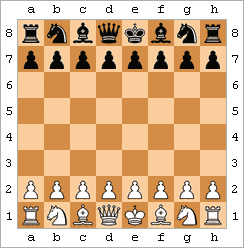
"Scholar's mate"
Chess games and positions are recorded using a system of notation, most commonly algebraic chess notation.[79] Abbreviated algebraic (or short algebraic) notation generally records moves in the format:
- abbreviation of the piece moved – file where it moved – rank where it moved
The pieces are identified by their initials. In English, these are K (king), Q (queen), R (rook), B (bishop), and N (knight; N is used to avoid confusion with king). For example, Qg5 means "queen moves to the g-file, 5th rank" (that is, to the square g5). Chess literature published in other languages may use different initials for pieces, or figurine algebraic notation (FAN) may be used to avoid language issues. To resolve ambiguities, an additional letter or number is added to indicate the file or rank from which the piece moved (e.g. Ngf3 means "knight from the g-file moves to the square f3"; R1e2 means "rook on the first rank moves to e2"). The letter P for pawn is not used; so e4 means "pawn moves to the square e4".
If the piece makes a capture, "x" is inserted before the destination square. Thus Bxf3 means "bishop captures on f3". When a pawn makes a capture, the file from which the pawn departed is used in place of a piece initial, and ranks may be omitted if unambiguous. For example, exd5 (pawn on the e-file captures the piece on d5) or exd (pawn on the e-file captures a piece somewhere on the d-file). Particularly in Germany, some publications use ":" rather than "x" to indicate capture, but this is now rare. Some publications omit the capture symbol altogether; so exd5 would be rendered simply as ed.
If a pawn moves to its last rank, achieving promotion, the piece chosen is indicated after the move (for example, e1Q or e1=Q). Castling is indicated by the special notations 0-0 for kingside castling and 0-0-0 for queenside castling. An en passant capture is sometimes marked with the notation "e.p." A move that places the opponent's king in check usually has the notation "+" added (the notation "++" for a double check is considered obsolete). Checkmate can be indicated by "#". At the end of the game, "1–0" means White won, "0–1" means Black won, and "½–½" indicates a draw.[80]
Chess moves can be annotated with punctuation marks and other symbols. (For example: "!" indicates a good move; "!!" an excellent move; "?" a mistake; "??" a blunder; "!?" an interesting move that may not be best; or "?!" a dubious move not easily refuted.[81])
For example, one variation of a simple trap known as the Scholar's mate (see animated diagram) can be recorded:
The text-based Portable Game Notation (PGN), which is understood by chess software, is based on short form English language algebraic notation.
Until about 1980, the majority of English language chess publications used a form of descriptive notation. In descriptive notation, files are named according to the piece which occupies the back rank at the start of the game, and each square has two different names depending on whether it is from White's or Black's point of view. For example, the square known as "e3" in algebraic notation is "K3" (King's 3rd) from White's point of view, and "K6" (King's 6th) from Black's point of view. When recording captures, the captured piece is named rather than the square on which it is captured (except to resolve ambiguities). Thus, Scholar's mate is rendered in descriptive notation:
- **1. P-K4 P-K4 2. Q-R5?! N-QB3 3. B-B4 N-B3?? 4. QxBPmate**
A few players still prefer descriptive notation, but it is no longer recognized by FIDE.
Another system is ICCF numeric notation, recognized by the International Correspondence Chess Federation though its use is in decline. Squares are identified by numeric coordinates, for example a1 is "11" and h8 is "88". Moves are described by the "from" and "to" squares, e.g. the opening move 1.e4 is rendered as 1.5254. Captures are not indicated. Castling is described by the king's move only; e.g. 5171 for White castling kingside, 5838 for Black castling queenside.
Stages
A game of chess can generally be loosely subdivided into three phases or stages of play: the opening, followed by the middlegame, then last the endgame.
Opening
A chess opening is the group of initial moves of a game (the "opening moves"). Recognized sequences of opening moves are referred to as openings and have been given names such as the Ruy Lopez or Sicilian Defense. They are catalogued in reference works such as the Encyclopaedia of Chess Openings. There are dozens of different openings, varying widely in character from quiet positional play (for example, the Réti Opening) to very aggressive (the Latvian Gambit). In some opening lines, the exact sequence considered best for both sides has been worked out to more than 30 moves.[82] Professional players spend years studying openings and continue doing so throughout their careers, as opening theory continues to evolve.
The fundamental strategic aims of most openings are similar:[83]
development: This is the technique of placing the pieces (particularly bishops and knights) on useful squares where they will have an optimal impact on the game.
control of the center: Control of the central squares allows pieces to be moved to any part of the board relatively easily, and can also have a cramping effect on the opponent.
king safety: It is critical to keep the king safe from dangerous possibilities. A correctly timed castling can often enhance this.
pawn structure: Players strive to avoid the creation of pawn weaknesses such as isolated, doubled, or backward pawns, and pawn islands – and to force such weaknesses in the opponent's position.
Most players and theoreticians consider that White, by virtue of the first move, begins the game with a small advantage. This initially gives White the initiative.[84] Black usually strives to neutralize White's advantage and achieve equality, or to develop dynamic counterplay in an unbalanced position.
Middlegame
The middlegame is the part of the game which starts after the opening. There is no clear line between the opening and the middlegame, but typically the middlegame will start when most pieces have been developed. (Similarly, there is no clear transition from the middlegame to the endgame; see start of the endgame.) Because the opening theory has ended, players have to form plans based on the features of the position, and at the same time take into account the tactical possibilities of the position.[85] The middlegame is the phase in which most combinations occur. Combinations are a series of tactical moves executed to achieve some gain. Middlegame combinations are often connected with an attack against the opponent's king. Some typical patterns have their own names; for example, the Boden's Mate or the Lasker–Bauer combination.[86]
Specific plans or strategic themes will often arise from particular groups of openings which result in a specific type of pawn structure. An example is the minority attack, which is the attack of queenside pawns against an opponent who has more pawns on the queenside. The study of openings is therefore connected to the preparation of plans that are typical of the resulting middlegames.[87]
Another important strategic question in the middlegame is whether and how to reduce material and transition into an endgame (i.e. simplify). Minor material advantages can generally be transformed into victory only in an endgame, and therefore the stronger side must choose an appropriate way to achieve an ending. Not every reduction of material is good for this purpose; for example, if one side keeps a light-squared bishop and the opponent has a dark-squared one, the transformation into a bishops and pawns ending is usually advantageous for the weaker side only, because an endgame with bishops on opposite colors is likely to be a draw, even with an advantage of a pawn, or sometimes even with a two-pawn advantage.[88]
Endgame

The side having to move is disadvantaged.
The endgame (also end game or ending) is the stage of the game when there are few pieces left on the board. There are three main strategic differences between earlier stages of the game and the endgame:[89]
Pawns become more important. Endgames often revolve around endeavors to promote a pawn by advancing it to the furthest rank.
The king, which requires safeguarding from attack during the middlegame, emerges as a strong piece in the endgame. It is often brought to the center where it can protect its own pawns, attack enemy pawns, and hinder moves of the opponent's king.
Zugzwang, a situation in which the player who is to move is forced to incur a disadvantage, is often a factor in endgames but rarely in other stages of the game. In the example diagram, either side having the move is in zugzwang: Black to move must play 1...Kb7 allowing White to promote the pawn after 2.Kd7; White to move must permit a draw, either by 1.Kc6 stalemate or by losing the pawn after any other legal move.
Endgames can be classified according to the type of pieces remaining on the board. Basic checkmates are positions in which one side has only a king and the other side has one or two pieces and can checkmate the opposing king, with the pieces working together with their king. For example, king and pawn endgames involve only kings and pawns on one or both sides, and the task of the stronger side is to promote one of the pawns. Other more complicated endings are classified according to pieces on the board other than kings, such as "rook and pawn versus rook" endgames.
Strategy and tactics
Chess strategy consists of setting and achieving long-term positioning advantages during the game – for example, where to place different pieces – while tactics concentrate on immediate maneuver. These two aspects of the gameplay cannot be completely separated, because strategic goals are mostly achieved through tactics, while the tactical opportunities are based on the previous strategy of play. A game of chess is normally divided into three phases: the opening, typically the first 10 moves, when players move their pieces to useful positions for the coming battle; the middlegame; and last the endgame, when most of the pieces are gone, kings typically take a more active part in the struggle, and pawn promotion is often decisive.
Fundamentals of tactics

After sacrificing a piece to expose Black's king, Botvinnik played 23.Bh5+ and Yudovich resigned, as mate is inevitable. 23.Bh5+ and now:
23...Kxh5 24.Ng3+ Kh4 25.Qe4+ Rf4 26.Qxf4# 23...Kf5 24.g4# 23...Kh7 24.Nf6+ (double check) Kh8 25.Qh7#
In chess, tactics in general concentrate on short-term actions – so short-term that they can be calculated in advance by a human player or a computer. The possible depth of calculation depends on the player's ability. In quiet positions with many possibilities on both sides, a deep calculation is more difficult and may not be practical, while in positions with a limited number of forced variations, strong players can calculate long sequences of moves.
Theoreticians describe many elementary tactical methods and typical maneuvers, for example: pins, forks, skewers, batteries, discovered attacks (especially discovered checks), zwischenzugs, deflections, decoys, sacrifices, underminings, overloadings, and interferences.[91] Simple one-move or two-move tactical actions – threats, exchanges of material, and double attacks – can be combined into more complicated sequences of tactical maneuvers that are often forced from the point of view of one or both players.[92] A forced variation that involves a sacrifice and usually results in a tangible gain is called a combination.[92] Brilliant combinations – such as those in the Immortal Game – are considered beautiful and are admired by chess lovers. A common type of chess exercise, aimed at developing players' skills, is a position where a decisive combination is available and the challenge is to find it.[93]
Fundamentals of strategy
Chess strategy is concerned with evaluation of chess positions and with setting up goals and long-term plans for the future play. During the evaluation, players must take into account numerous factors such as the value of the pieces on the board, control of the center and centralization, the pawn structure, king safety, and the control of key squares or groups of squares (for example, diagonals, open files, and dark or light squares).
The most basic step in evaluating a position is to count the total value of pieces of both sides.[94] The point values used for this purpose are based on experience; usually pawns are considered worth one point, knights and bishops about three points each, rooks about five points (the value difference between a rook and a bishop or knight being known as the exchange), and queens about nine points. The king is more valuable than all of the other pieces combined, since its checkmate loses the game. But in practical terms, in the endgame the king as a fighting piece is generally more powerful than a bishop or knight but less powerful than a rook.[95] These basic values are then modified by other factors like position of the piece (e.g. advanced pawns are usually more valuable than those on their initial squares), coordination between pieces (e.g. a pair of bishops usually coordinate better than a bishop and a knight), or the type of position (e.g. knights are generally better in closed positions with many pawns while bishops are more powerful in open positions).[96]
After 12...Re8 in Tarrasch–Euwe...[97] |
...and its pawn "Rauzer formation" | ||||||||||||||||||||||||||||||||||||||||||||||||||||||||||||||||||||||||||||||||||||||||
Another important factor in the evaluation of chess positions is the pawn structure (sometimes known as the pawn skeleton): the configuration of pawns on the chessboard.[98] Since pawns are the least mobile of the pieces, the pawn structure is relatively static and largely determines the strategic nature of the position. Weaknesses in the pawn structure, such as isolated, doubled, or backward pawns and holes, once created, are often permanent. Care must therefore be taken to avoid these weaknesses unless they are compensated by another valuable asset (for example, by the possibility of developing an attack).[99]
Competitive play
Organization of competitions

Former world champion Viswanathan Anand (left) playing against his predecessor Vladimir Kramnik
Contemporary chess is an organized sport with structured international and national leagues, tournaments, and congresses. Chess's international governing body is FIDE (Fédération Internationale des Échecs). Most countries have a national chess organization as well (such as the US Chess Federation and English Chess Federation) which in turn is a member of FIDE. FIDE is a member of the International Olympic Committee,[100] but the game of chess has never been part of the Olympic Games; chess does have its own Olympiad, held every two years as a team event.
The current World Chess Champion is Magnus Carlsen of Norway.[101] The reigning Women's World Champion is Hou Yifan from China.[102] The world's highest rated female player, Judit Polgár, has never participated in the Women's World Chess Championship, instead preferring to compete with the leading men and maintaining a ranking among the top male players.[103]
Other competitions for individuals include the World Junior Chess Championship, the European Individual Chess Championship, and the National Chess Championships. Invitation-only tournaments regularly attract the world's strongest players. Examples include Spain's Linares event, Monte Carlo's Melody Amber tournament, the Dortmund Sparkassen meeting, Sofia's M-tel Masters, and Wijk aan Zee's Tata Steel tournament.
Regular team chess events include the Chess Olympiad and the European Team Chess Championship. The World Chess Solving Championship and World Correspondence Chess Championships include both team and individual events.
Besides these prestigious competitions, there are thousands of other chess tournaments, matches, and festivals held around the world every year catering to players of all levels. Chess is promoted as a "mind sport" by the Mind Sports Organisation, alongside other mental-skill games such as contract bridge, Go, and Scrabble.
Titles and rankings
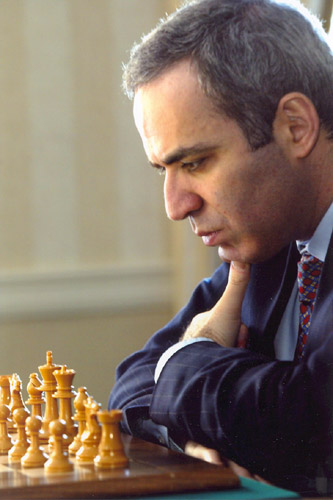
GM Garry Kasparov, former World Chess Champion, is considered by many to be one of the greatest chess players of all time.
The best players can be awarded specific lifetime titles by the world chess organization FIDE:[104]
Grandmaster (shortened as GM; sometimes International Grandmaster or IGM is used) is awarded to world-class chess masters. Apart from World Champion, Grandmaster is the highest title a chess player can attain. Before FIDE will confer the title on a player, the player must have an Elo chess rating (see below) of at least 2500 at one time and three favorable results (called norms) in tournaments involving other grandmasters, including some from countries other than the applicant's. There are other milestones a player can achieve to attain the title, such as winning the World Junior Championship.
International Master (shortened as IM). The conditions are similar to GM, but less demanding. The minimum rating for the IM title is 2400.
FIDE Master (shortened as FM). The usual way for a player to qualify for the FIDE Master title is by achieving a FIDE rating of 2300 or more.
Candidate Master (shortened as CM). Similar to FM, but with a FIDE rating of at least 2200.
All the titles are open to men and women. Separate women-only titles, such as Woman Grandmaster (WGM), are available. Beginning with Nona Gaprindashvili in 1978, a number of women have earned the GM title, and most of the top ten women in 2006 hold the unrestricted GM title.[5]
As of 2018, there are 1725 active grandmasters and 3903 international masters in the world. The top three countries with the largest numbers of grandmasters are Russia, the United States, and Germany, with 251, 98, and 96, respectively.[105]
International titles are awarded to composers and solvers of chess problems and to correspondence chess players (by the International Correspondence Chess Federation). National chess organizations may also award titles, usually to the advanced players still under the level needed for international titles; an example is the chess expert title used in the United States.
In order to rank players, FIDE, ICCF, and national chess organizations use the Elo rating system developed by Arpad Elo. Elo is a statistical system based on the assumption that the chess performance of each player in his or her games is a random variable. Arpad Elo thought of a player's true skill as the average of that player's performance random variable, and showed how to estimate the average from results of player's games. The US Chess Federation implemented Elo's suggestions in 1960, and the system quickly gained recognition as being both fairer and more accurate than older systems; it was adopted by FIDE in 1970.[6] A beginner or casual player typically has an Elo rating of less than 1000; an ordinary club player has a rating of about 1500, a strong club player about 2000, a grandmaster usually has a rating of over 2500, and an elite player has a rating of over 2700. The highest FIDE rating of all time, 2881, was achieved by Magnus Carlsen on the March 2014 FIDE rating list.[108]
Composition
Chess composition is the art of creating chess problems (also called chess compositions). The creator is known as a chess composer.[109] There are many types of chess problems; the two most important are:
Directmates: White to move first and checkmate Black within a specified number of moves, against any defense. These are often referred to as "mate in n" – for example "mate in three" (a three-mover); two- and three-move problems are the most common. These usually involve positions that would be highly unlikely to occur in an actual game, and are intended to illustrate a particular theme, usually requiring a surprising or counter-intuitive key move.[110]
Studies: orthodox problems where the stipulation is that White to play must win or draw. Almost all studies are endgame positions.[111]
Chess composition is a distinct branch of chess sport, and tournaments exist for both the composition and solving of chess problems.[112]
Example

White to move and draw
This is one of the most famous chess studies; it was published by Richard Réti 4 December 1921. It seems impossible to catch the advanced black pawn, while the black king can easily stop the white pawn. The solution is a diagonal advance, which brings the king to both pawns simultaneously:
- **1. Kg7!h4 2. Kf6! Kb6**
Or 2...h3 3.Ke7 and the white king can support its pawn.
- **3. Ke5!!**
Now the white king comes just in time to support his pawn, or catch the black one.
- 3... h3
If 3...Kxc6, 4.Kf4 and White will capture the pawn.
- **4. Kd6½–½**
Both sides will queen, resulting in a draw.[113]
Publications
Chess has a very extensive literature. In 1913, the chess historian H.J.R. Murray estimated the total number of books, magazines, and chess columns in newspapers to be about 5,000.[114][115] B.H. Wood estimated the number, as of 1949, to be about 20,000.[115] David Hooper and Kenneth Whyld write that, "Since then there has been a steady increase year by year of the number of new chess publications. No one knows how many have been printed."[115] There are two significant public chess libraries: the John G. White Chess and Checkers Collection at Cleveland Public Library, with over 32,000 chess books and over 6,000 bound volumes of chess periodicals;[116] and the Chess & Draughts collection at the National Library of the Netherlands, with about 30,000 books.[117] GM Lothar Schmid owned the world's largest private collection of chess books and memorabilia.[118] David DeLucia's chess library contains 7,000 to 8,000 chess books, a similar number of autographs (letters, score sheets, manuscripts), and about 1,000 items of "ephemera".[119] Dirk Jan ten Geuzendam opines that DeLucia's collection "is arguably the finest chess collection in the world".[120]
Mathematics and computers
The game structure and nature of chess are related to several branches of mathematics. Many combinatorical and topological problems connected to chess have been known for hundreds of years.
Combinatorics of chess and chess puzzles

Mathematicians Euler, Legendre, de Moivre, and Vandermonde studied the knight's tour.
The number of legal positions in chess is estimated to be about 1043, and has been proved to be fewer than 1047,[121][122] with a game-tree complexity of approximately 10123. The game-tree complexity of chess was first calculated by Claude Shannon as 10120, a number known as the Shannon number.[123] An average position typically has thirty to forty possible moves, but there may be as few as zero (in the case of checkmate or stalemate) or (in a constructed position) as many as 218.[124]
Chess has inspired many combinatorial puzzles, such as the knight's tour and the eight queens puzzle.
Computer chess
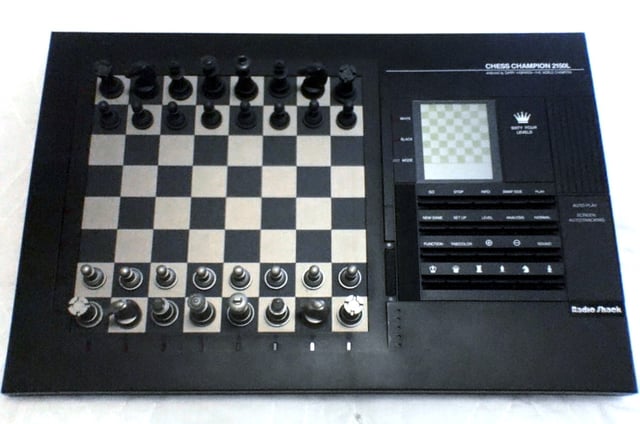
1990s chess-playing computer
The idea of creating a chess-playing machine dates to the 18th century; around 1769, the chess-playing automaton called The Turk became famous before being exposed as a hoax.[125] Serious trials based on automata, such as El Ajedrecista, were too complex and limited to be useful.
Since the advent of the digital computer in the 1950s, chess enthusiasts, computer engineers, and computer scientists have built, with increasing degrees of seriousness and success, chess-playing machines and computer programs.[126] The groundbreaking paper on computer chess, "Programming a Computer for Playing Chess", was published in 1950 by Shannon.[7] He wrote:
The chess machine is an ideal one to start with, since: (1) the problem is sharply defined both in allowed operations (the moves) and in the ultimate goal (checkmate); (2) it is neither so simple as to be trivial nor too difficult for satisfactory solution; (3) chess is generally considered to require "thinking" for skillful play; a solution of this problem will force us either to admit the possibility of a mechanized thinking or to further restrict our concept of "thinking"; (4) the discrete structure of chess fits well into the digital nature of modern computers.[128]
The Association for Computing Machinery (ACM) held the first major chess tournament for computers, the North American Computer Chess Championship, in September 1970. CHESS 3.0, a chess program from Northwestern University, won the championship. Nowadays, chess programs compete in the World Computer Chess Championship, held annually since 1974. At first considered only a curiosity, the best chess playing programs have become extremely strong. In 1997, a computer won a chess match using classical time controls against a reigning World Champion for the first time: IBM's Deep Blue beat Garry Kasparov 3½–2½ (it scored two wins, one loss, and three draws).[129][130] However, the match was controversial,[131] and computers would only win such a match again in 2006.
In 2009, a mobile phone won a category 6 tournament with a performance rating 2898: chess engine Hiarcs 13 running on the mobile phone HTC Touch HD won the Copa Mercosur tournament with nine wins and one draw.[132] The best chess programs are now able to consistently beat the strongest human players, to the extent that human–computer matches no longer attract interest from chess players or media.
With huge databases of past games and high analytical ability, computers can help players to learn chess and prepare for matches. Internet Chess Servers allow people to find and play opponents worldwide. The presence of computers and modern communication tools have raised concerns regarding cheating during games, most notably the "bathroom controversy" during the 2006 World Championship.[133]
Relation to game theory
In 1913, Ernst Zermelo used chess as a basis for his theory of game strategies, which is considered as one of the predecessors of game theory.[134] Zermelo's theorem states that it is possible to solve chess, i.e. to determine with certainty the outcome of a perfectly played game (either White can force a win, or Black can force a win, or both sides can force at least a draw).[135] According to Claude Shannon, however, there are 1043 legal positions in chess, so it will take an impossibly long time to compute a perfect strategy with any feasible technology.[136]
The 11-category, game theoretical taxonomy of chess includes: two player, no-chance, combinatorial, Markov state (present state is all a player needs to move; although past state led up to that point, knowledge of the sequence of past moves is not required to make the next move, except to take into account of en passant and castling, which do depend on the past moves), zero sum, symmetric, perfect information, non-cooperative, discrete, extensive form (tree decisions, not payoff matrices), and sequential.[137]
Computational complexity
Generalized chess (played on n×n board, without the fifty-move rule) is EXPTIME-complete.[138]
Combinatorial game theory
Some applications of combinatorial game theory to chess endgames were found by Elkies (1996).[139]
Psychology
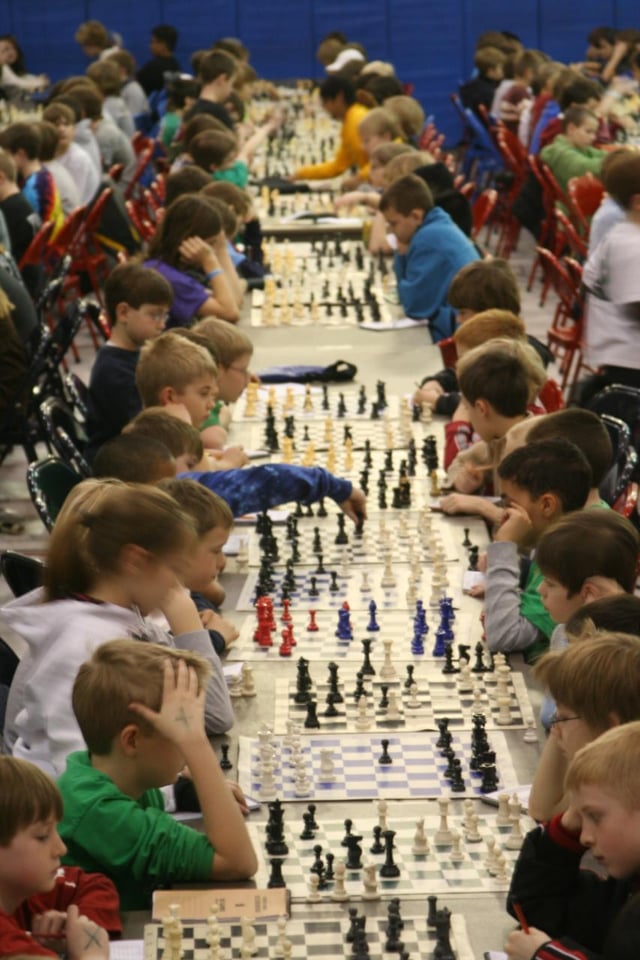
A children's chess tournament in the United States
There is an extensive scientific literature on chess psychology.[8][9][141][142][143][144] Alfred Binet and others showed that knowledge and verbal, rather than visuospatial, ability lies at the core of expertise.[145][146] In his doctoral thesis, Adriaan de Groot showed that chess masters can rapidly perceive the key features of a position.[147] According to de Groot, this perception, made possible by years of practice and study, is more important than the sheer ability to anticipate moves. De Groot showed that chess masters can memorize positions shown for a few seconds almost perfectly. The ability to memorize does not alone account for chess-playing skill, since masters and novices, when faced with random arrangements of chess pieces, had equivalent recall (about six positions in each case). Rather, it is the ability to recognize patterns, which are then memorized, which distinguished the skilled players from the novices. When the positions of the pieces were taken from an actual game, the masters had almost total positional recall.[148]
More recent research has focused on chess as mental training; the respective roles of knowledge and look-ahead search; brain imaging studies of chess masters and novices; blindfold chess; the role of personality and intelligence in chess skill; gender differences; and computational models of chess expertise. The role of practice and talent in the development of chess and other domains of expertise has led to much recent research. Ericsson and colleagues have argued that deliberate practice is sufficient for reaching high levels of expertise in chess.[149] Recent research indicates that factors other than practice are also important. For example, Fernand Gobet and colleagues have shown that stronger players started playing chess at a young age and that experts born in the Northern Hemisphere are more likely to have been born in late winter and early spring. Compared to general population, chess players are more likely to be non-right-handed, though they found no correlation between handedness and skill.[150]
Chess and intelligence
A relationship between chess skill and intelligence has long been discussed in the literature and popular culture. Academic studies of the relationship date back at least to 1927.[151][152] Academic opinion has long been split on how strong the relationship is, with some studies finding no relationship and others finding a relatively strong one.[153][152] A 2016 meta-analysis and review based on 19 studies and a total sample size of 1,779 found that various aspects of general intelligence correlate with chess skill, with average correlations ranging from 0.13 (visuospatial ability) to 0.35 (numerical ability).[152] The review did not find strong evidence of publication bias biasing these estimates. Moderator analyses indicated that the relationship was stronger in unranked players (r = 0.32) vs. ranked players (r = 0.14), as well as stronger in children (r = 0.32) than adults (r = 0.11).
Variants

Gliński's hexagonal chess, launched in 1949, became popular in Eastern Europe, reaching half a million fans. Three cell colors and three bishops per side are the norm for hexagonal variants.
Direct predecessors of chess such as chaturanga and shatranj.
Traditional national or regional games that share common ancestors with Western chess such as xiangqi, shogi, janggi, makruk, and sittuyin.
Modern variations employing different rules (e.g. Losing chess), different forces (e.g. Dunsany's Chess), non-standard pieces (e.g. Grand Chess), or different board geometries (e.g. hexagonal chess). One rules variant that has gained significantly in popularity is Chess960 (named "Fischerandom" by its inventor). In Chess960, the starting position is selected randomly from 960 unique possibilities, including the classic chess initial position without change, while the other 959 render the use of prepared opening lines impracticable.[156] In 2008, FIDE added Chess960 to its Handbook.[10]
Infinite chess, which has drawn the attention of mathematicians.[159]
Prime sources in English describing chess variants and their rules include David Pritchard's encyclopedias,[160] the website The Chess Variant Pages created by Hans Bodlaender with various contributors, and the magazine Variant Chess published from 1990 (George Jellis) to 2010 (the British Chess Variants Society).
See also
Reference aids
Outline of chess (subject-wide table of contents)
Glossary of chess
Index of chess articles
Lists
List of chess books
List of chess games
List of chess players
List of chess world championship matches
List of strong chess tournaments


